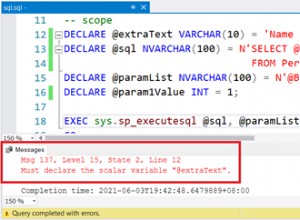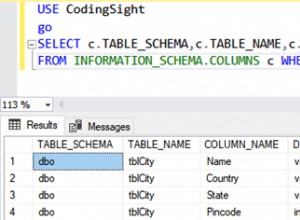Si no desea utilizar una sintaxis fluida, existen otras tres formas de implementar la referencia mediante anotaciones de datos (personalmente, prefiero las anotaciones de datos, ya que parecen más fáciles de leer y están escritas justo encima de la propiedad a la que afectan):
1.1)Usar ForeignKey (con una propiedad asociada) - versión 1
[Table("WIDGETENTITIES")]
public class WidgetEntity {
[Column("WIDGETENTITY_ID")]
public int Id { get; set; }
[Column("WIDGETSEQUENCE_ID")]
public int WidgetSequenceId { get; set; }
[ForeignKey("WidgetSequenceId")] //Has to be a property name, not table column name
public WidgetSequence Sequence { get; set; }
// and other properties that map correctly
}
[Table("WIDGETSEQUENCES")]
public class WidgetSequence {
[Column("WIDGETSEQUENCE_ID")]
public int Id { get; set; }
[Column("NUMBER")]
public int Number { get; set; }
}
1.2)Usar ForeignKey (con una propiedad asociada) - versión 2
[Table("WIDGETENTITIES")]
public class WidgetEntity {
[Column("WIDGETENTITY_ID")]
public int Id { get; set; }
[ForeignKey("Sequence")] //Has to be a property name, not table column name
[Column("WIDGETSEQUENCE_ID")]
public int WidgetSequenceId { get; set; }
public WidgetSequence Sequence { get; set; }
// and other properties that map correctly
}
[Table("WIDGETSEQUENCES")]
public class WidgetSequence {
[Column("WIDGETSEQUENCE_ID")]
public int Id { get; set; }
[Column("NUMBER")]
public int Number { get; set; }
}
2) También puede usar InversePropertyAttribute.
[Table("WIDGETENTITIES")]
public class WidgetEntity {
[Column("WIDGETENTITY_ID")]
public int Id { get; set; }
[InverseProperty("WidgetEntities")]
public WidgetSequence Sequence { get; set; }
// and other properties that map correctly
}
[Table("WIDGETSEQUENCES")]
public class WidgetSequence {
[Column("WIDGETSEQUENCE_ID")]
public int Id { get; set; }
[Column("NUMBER")]
public int Number { get; set; }
public virtual List<WidgetEntity> WidgetEntities { get; set; }
}




